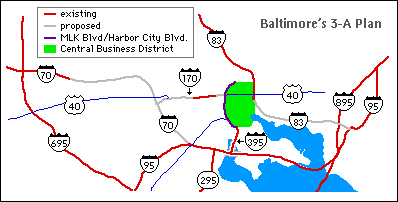Roads
Home
Updated July 20, 2000
 Hope this helps where text doesn't give the big picture. I will do more of these maps
as time permits. There's more detailed information on Interstates
170,
395,
695, and
895.
Other Baltimore 3-digit interstates, off the scale of this map, include
I-195, serving the airport, and
I-795, a spur northwest from I-695.
Hope this helps where text doesn't give the big picture. I will do more of these maps
as time permits. There's more detailed information on Interstates
170,
395,
695, and
895.
Other Baltimore 3-digit interstates, off the scale of this map, include
I-195, serving the airport, and
I-795, a spur northwest from I-695.
This page is merely the "encyclopedia" version of Baltimore expressway development. You should also see two pages by Scott Kozel: Baltimore Interstates and Baltimore Expressway Planning.
Pictured is Baltimore's "3-A Interstate and Boulevard System," a master plan dating back to 1968. In a nutshell, I-70 would have connected to I-95 near exit 50, Washington Blvd, and I-83 would have skirted the Central Business District (CBD) to the northeast, connecting with I-95 near exit 58, O'Donnell St. The I-170 and I-395 spurs would have CBD. A few isolated miles of I-170 were built, which is now signed US 40; I-395 was built in its entirety; I-83 stops short of I-95; and I-70 ends at a Park & Ride just past I-695.
I-395, I-170 and I-83 were not planned to connect. Left unattended, the effect of freeways dumping crosstown traffic onto city streets would have been adverse. Baltimore's solution: a non-interstate at-grade "City Boulevard" ringing the CBD to the west, with connections to I-395 and I-170: "something more than a city street, but something less than an expressway."
The 1.5 mile, six-lane Harbor City Blvd. (Martin Luther King, Jr. Blvd.) runs from I-395/Russell St. to Eutaw St./Biddle St., skirting the west edge of the CBD. Designed as a transitional interface between the city streets and the termini of 395 and 170, the Boulevard also serves as an urban western local bypass of the CBD. Instead of the freeways dumping their huge volume of traffic out only at their termini, the traffic distributes onto Harbor City Blvd., and distributes from there onto many city streets. The reverse works when entering the spurs. This concept maximizes the huge capacity of the spurs.
Source: Scott Kozel, MDOT documents
